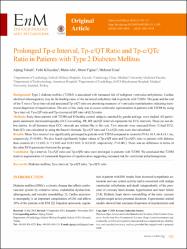| dc.contributor.author | Tokatlı, Alptuğ | |
| dc.contributor.author | Kılıçaslan, Fethi | |
| dc.contributor.author | Alış, Metin | |
| dc.contributor.author | Yiğiner, Ömer | |
| dc.contributor.author | Uzun, Mehmet | |
| dc.date.accessioned | 10.07.201910:49:13 | |
| dc.date.accessioned | 2019-07-10T19:52:04Z | |
| dc.date.available | 10.07.201910:49:13 | |
| dc.date.available | 2019-07-10T19:52:04Z | |
| dc.date.issued | 2016 | en_US |
| dc.identifier.citation | Tokatlı, A., Kılıçaslan, F., Alış, M., Yiğiner, Ö. ve Uzun, M. (2016). Prolonged Tp-e interval, Tp-e/QT ratio and Tp-e/QTc ratio in patients with Type 2 diabetes mellitus. Endocrinology And Metabolism, 31(1), 105-112. https://dx.doi.org/10.3803/EnM.2016.31.1.105 | en_US |
| dc.identifier.issn | 2093-596X | |
| dc.identifier.issn | 2093-5978 | |
| dc.identifier.uri | https://dx.doi.org/10.3803/EnM.2016.31.1.105 | |
| dc.identifier.uri | https://hdl.handle.net/20.500.12511/2335 | |
| dc.description | WOS: 000407801900016 | en_US |
| dc.description | PubMed ID: 26676332 | en_US |
| dc.description.abstract | Background: Type 2 diabetes mellitus (T2DM) is associated \vith increased risk of malignant ventricular arrhythmias. Cardiac electrical inhomogeneity may be the leading cause of the increased arrhythmic risk in patients with T2DM. The peak and the end of the T wave (Tp-e) interval and associated Tp-e/QT ratio are promising measures of ventricular repolarization indicating trans mural dispersion of repolarization. The aim of this study was to assess ventricular repolarization in patients with T2DM by using Tp-e interval, Tp-e'QT ratio and Tp-e'corrected QT interval (QTc) ratio. Method: Forty-three patients with T2DM and 43 healthy control subjects, matched by gender and age, were studied. All participants underwent electrocardiography (ECG) recording. PR. RR and QT intervals represents the ECG intervals. These are not abbreviations. In all literature these ECG intervals are written like in this text. Tp-e intervals were measured from 12 -lead ECG. Rate QTc was calculated by using the l3azett's formula. Tp-e/QT ratio and Tp-e/Q-fc ratio were also calculated. Result: Mean Tp-e interval was significantly prolonged in patients with T2DM compared to controls (79.4 +/- 10.3, 66.4 +/- 8.1 respectively: P<0.001). We also found significantly higher values of Tp-e/QT ratio and Tp-e/QTc ratio in patients with diabetes than controls (0.21 +/- 0.03, 0.17 +/- 0.02 and 0.19 +/- 0.02, 0.16 +/- 0.02, respectively; P<0.001). There was no difference in terms of the other ECG parameters between the groups. Conclusion: Tp-e interval. Tp-e/QT ratio and Tp-e/QTc ratio were prolonged in patients with T2DM. We concluded that T2DM leads to augmentation of transmural dispersion of repolarization suggesting increased risk lbr ventricular arrhythmogenesis. | en_US |
| dc.language.iso | eng | en_US |
| dc.publisher | Korean Endocrine Soc | en_US |
| dc.rights | info:eu-repo/semantics/openAccess | en_US |
| dc.rights | Attribution-NonCommercial 4.0 International | * |
| dc.rights.uri | https://creativecommons.org/licenses/by-nc/4.0/ | * |
| dc.subject | Diabetes Mellitus | en_US |
| dc.subject | Tp-e interval | en_US |
| dc.subject | Tp-e/QT Ratio | en_US |
| dc.subject | Tp-e/QTc Ratio | en_US |
| dc.title | Prolonged Tp-e interval, Tp-e/QT ratio and Tp-e/QTc ratio in patients with Type 2 diabetes mellitus | en_US |
| dc.type | article | en_US |
| dc.relation.ispartof | Endocrinology And Metabolism | en_US |
| dc.department | İstanbul Medipol Üniversitesi, Tıp Fakültesi, Dahili Tıp Bilimleri Bölümü, Kardiyoloji Ana Bilim Dalı | en_US |
| dc.identifier.volume | 31 | en_US |
| dc.identifier.issue | 1 | en_US |
| dc.identifier.startpage | 105 | en_US |
| dc.identifier.endpage | 112 | en_US |
| dc.relation.publicationcategory | Makale - Uluslararası Hakemli Dergi - Kurum Öğretim Elemanı | en_US |
| dc.identifier.doi | 10.3803/EnM.2016.31.1.105 | en_US |
| dc.identifier.wosquality | Q2 | en_US |
| dc.identifier.scopusquality | Q2 | en_US |



















